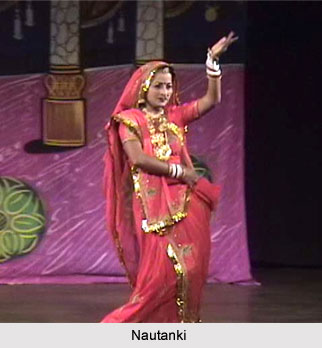 History of Nautanki performance tradition goes back many hundred years. The origin of Nautanki lies in the traditional folk performances of Swang, Bhagat and Raasleela of Mathura and Vrindavan in Uttar Pradesh, and Khayal of Rajasthan. The history of Nautanki becomes clear in the 19th century with the coming of printing press in India and publication of Nautanki operas in the form of chapbooks.
History of Nautanki performance tradition goes back many hundred years. The origin of Nautanki lies in the traditional folk performances of Swang, Bhagat and Raasleela of Mathura and Vrindavan in Uttar Pradesh, and Khayal of Rajasthan. The history of Nautanki becomes clear in the 19th century with the coming of printing press in India and publication of Nautanki operas in the form of chapbooks.
The Nautanki reached the top of its glory in the early part of 20th century when many Nautanki performing troupes known as mandalis (which literally means groups) and akharas (which literally means wrestling arenas) came into being. The Nautanki mandalis were called akharas due to the prevalence of particular style of singing in Nautanki that required a lot of physical power.
The Nautanki that is staged by these Akharas also became the main source of entertainment in the small villages and towns of Northern India, and remained the same until TV and VCRs began to make inroads beginnings in the early 1990s. Nautanki, riding on the popularity, progressed both in terms of forms as well as content and its stage became bigger and more professional. Some of the examples of Nautanki companies, like, Natharam`s mandali, catching the cue from big Parsi theatre (an urban Indian theatre style) troupes such as Alfred Theatre Company, started to present their performances outside the core region of its audience. Some performances occurred as far as in Myanmar.
Even today, Nautanki still holds strong influences over imagination of rural peoples and even after the spread of mass media (such as television and radio), a crowd of 10,000 to 15,000 can be seen at the top Nautanki performances. Like many other folk forms of India, Nautanki`s status has been badly affected by the indifference of the political leadership, and the attitude of looking down upon the native Indian artistic traditions by the influential urban-based elites suffering from a post-colonial hangover (colonial after-effects on the psychology of Indian elites.



















